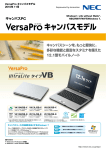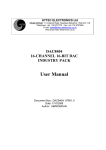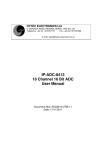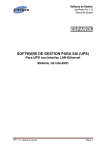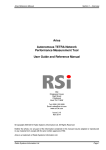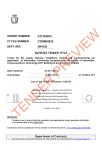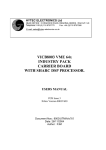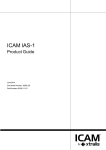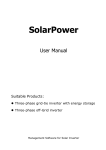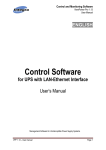Download User Manual - Hytec Electronics Ltd
Transcript
HYTEC ELECTRONICS Ltd 5 CRADOCK ROAD, READING, BERKS. RG2 0JT, UK Telephone: +44 (0) 118 9757770 Fax: +44 (0)118 9757566 E-mail: [email protected] Copyright 2011, Hytec Electronics Ltd Data and specifications are subject to change without notice MCS8522 MULTI-CHANNEL SCALER INDUSTRY PACK USERS MANUAL PCB Issue 1.0 Firmware Versions: Histogram Mode LVDS\TTL V103 Histogram Mode LVDS\TTL V104 Histogram Mode LVDS\TTL V105 Preset Scaler Mode LVDS\TTL V103 Document Nos.: MCS8522/UTM/G/x/3.0 Date: 18/12/2014 Author: MRN Hytec Electronics Ltd MCS8522/UTM/3.0 Revision History The following table shows the revision history for this document. Date Version 30/05/12 1.0 25/07/12 1.1 27/07/12 04/09/12 2.0 2.1 18/12/14 3.0 Revision Initial release. FF flag put in CSR. Unit does not start when nos cycles/triggers is set to zero. Unit does not start in Hist mode when Nos Gates per cycle is set to zero. Enter value required as opposed to not one less. Mem address reg in straight scaler mode shows next memory location to be written to. Dual boot for histogram mode or Preset scaler mode I/O configuration section expanded and added to contents page. In Histogram Mode add External Enable function and amend TTL logic level register to include External Enable bit level. CRITICAL APPLICATIONS DISCLAIMER THIS PRODUCT FROM HYTEC ELECTRONICS LTD USES COMPONENTS THAT ARE NOT DESIGNED OR INTENDED TO BE FAIL-SAFE, OR FOR USE IN ANY APPLICATION REQUIRING FAIL-SAFE PERFORMANCE, SUCH AS IN LIFE-SUPPORT OR SAFETY DEVICES OR SYSTEMS, CLASS III MEDICAL DEVICES, NUCLEAR FACILITIES, APPLICATIONS RELATED TO THE DEPLOYMENT OF AIRBAGS, OR ANY OTHER APPLICATIONS THAT COULD LEAD TO DEATH, PERSONAL INJURY OR SEVERE PROPERTY OR ENVIRONMENTAL DAMAGE (INDIVIDUALLY AND COLLECTIVELY, “CRITICAL APPLICATIONS”). FURTHERMORE, SOME COMPONENTS USED IN THIS HYTEC ELECTRONICS LTD PRODUCTS ARE NOT DESIGNED OR INTENDED FOR USE IN ANY APPLICATIONS THAT AFFECT CONTROL OF A VEHICLE OR AIRCRAFT, UNLESS THERE IS A FAIL-SAFE OR REDUNDANCY FEATURE AND A WARNING SIGNAL UPON FAILURE TO THE OPERATOR. THE CUSTOMER ASSUMES THE SOLE RISK AND LIABILITY OF ANY USE OF HYTEC ELECTRONICS LTD PRODUCT IN CRITICAL APPLICATIONS. Page 2 Hytec Electronics Ltd MCS8522/UTM/3.0 CONTENTS 1. INTRODUCTION ......................................................................................................................... 5 2. MODES OF OPERATION........................................................................................................... 6 2.1 2.2 2.3 HISTOGRAMMING MODE .......................................................................................................... 6 STRAIGHT SCALER MODE ........................................................................................................ 6 PRESET SCALER MODE ............................................................................................................ 6 3. PRODUCT SPECIFICATIONS .................................................................................................. 7 4. LOGIC SIGNAL LEVELS ........................................................................................................... 8 5. HISTOGRAM AND STRAIGHT SCALER OPERATING MODES ...................................... 9 5.1 HISTOGRAM MODE (MD0=’0’ IN CSR) .................................................................................. 9 5.1.1 Basic Histogram Mode .................................................................................................... 9 5.1.2 Histogram Coincidence Mode ....................................................................................... 10 5.1.3 Memory Layout for Histogram Mode............................................................................ 10 5.2 STRAIGHT SCALER MODE (MD0=’1’ IN CSR)...................................................................... 12 5.2.1 Memory Layout Straight Scaler Mode .......................................................................... 12 5.3 AUTOMATED MEMORY CLEAR ............................................................................................. 12 5.4 APPLICATION REGISTERS HISTOGRAM AND STRAIGHT SCALER ........................................... 13 5.4.1 Counting Registers (I/O Address 0-31) ......................................................................... 13 5.4.2 Coincidence Registers (I/O Address 32-47) .................................................................. 13 5.4.3 Control & Status Register (CSR I/O Address 48).......................................................... 14 5.4.4 Gate Interval (Bin Advance) Register (I/O address 49) ................................................ 14 5.4.5 Number of Cycles\Triggers Register (I/O address 50).................................................. 15 5.4.6 Number of Gates per cycle (memory depth) Register (I/O address 51) ........................ 15 5.4.7 Overflow Register (I/O address 52)............................................................................... 15 5.4.8 Nos "Cycles" and/or Triggers Received Register (IP address 53)................................ 15 5.4.9 Interrupt Vector Register (I/O address 54) ................................................................... 15 5.4.10 Interrupt Disable Register (I/O address 55) ................................................................. 16 5.4.11 Memory pointer LSW Register (I/O address 56) ........................................................... 16 5.4.12 Memory pointer MSW Register (I/O address 57).......................................................... 16 5.4.13 Mask Channel Input (I/O address 58) ........................................................................... 16 5.4.14 Change of Function Register (I/O address 59) ............................................................. 16 5.5 SELECT TTL LEVEL REGISTER (I/O ADDRESS 60) (ONLY IN VERSION V105 AND ABOVE).. 17 5.5.1 Counter Source (I/O address 62)................................................................................... 17 5.6 INTERNAL AND EXTERNAL RESET ......................................................................................... 17 5.7 EXTERNAL TIME BIN ADVANCE (EBA)................................................................................. 18 5.8 EXTERNAL TRIGGER ENABLE (ONLY IN VERSION V104 AND ABOVE) .................................. 18 5.9 MINIMUM DWELL TIME................................................................................................... 19 6. PRESET SCALER....................................................................................................................... 20 6.1 SETTING VALUE TO LOAD IN TO PRESET SCALER ................................................................. 20 6.2 APPLICATION REGISTERS PRESET SCALER ............................................................................ 20 6.2.1 Preset Counting and Shadow Registers (I/O Address 0-31) ......................................... 21 6.2.2 Control & Status Register (CSR I/O Address 48).......................................................... 21 6.2.3 Preset Hit Register (I/O address 52) ............................................................................. 21 6.2.4 Count Termination Mask Register (IP address 53)....................................................... 22 6.2.5 Interrupt Vector Register (I/O address 54) ................................................................... 22 6.2.6 Interrupt Disable Register (I/O address 55) ................................................................. 22 6.2.7 ARM Channel Input (I/O address 58)............................................................................ 22 6.2.8 Change of Function Register (I/O address 59) ............................................................. 22 6.2.9 Select TTL level (I/O address 60) .................................................................................. 23 Page 3 Hytec Electronics Ltd MCS8522/UTM/3.0 6.2.10 Counter Source (I/O address 62)................................................................................... 23 6.3 INTERNAL AND EXTERNAL RESET PRESET SCALER MODE .................................................... 23 7. ID PROM...................................................................................................................................... 24 8. I/O STANDARDS INPUT CONFIGURATION...................................................................... 25 8.1 8.2 8.3 LVPECL — LOW VOLTAGE POSITIVE EMITTER COUPLED LOGIC ....................................... 25 LVDS — LOW VOLTAGE DIFFERENTIAL SIGNAL ................................................................. 26 J1 PULL-UP OR PULL-DOWN FOR TTL LOGIC SIGNALS ......................................................... 26 APPENDIX A....................................................................................................................................... 27 APPENDIX B....................................................................................................................................... 28 APPENDIX C....................................................................................................................................... 29 APPENDIX D....................................................................................................................................... 30 Page 4 Hytec Electronics Ltd MCS8522/UTM/3.0 1. INTRODUCTION The Hytec IP-MSC-8522 is a single-width Industry Pack that provides 16 scalers channels with the following characteristics:• • • • • • • • • • • • • • • • • • • • • • 16 independent counting channels. 32-bit counter depth. Shadow register to allow on-the-fly reading of scalers. Full 32 bits binary count capacity and 64 bit histogram capability. 2Mbytes SRAM. Gate/Bin advance by internal timer or programmable number of external pulses. 200MHz Count rates (LVDS, LVPECL and NIM), 100MHz for TTL. TTL, LVDS and LVPECL inputs (Input type must be specified when ordered). Input type can be reconfigured in the field via the JTAG port if requirements change. NIM input via dedicated terminal block. Each scaler has a 16 bit input coincidence pattern register. Interrupt on completion of programmed number of cycles/triggers/counts. External hardware trigger (software enable) or software trigger. Trigger output to allow Trigger In / Out daisy-chain connection for synchronisation. Software and external hardware reset of scalers and memory. Scaler external inputs via transition board. Trigger ignored if cycle has not completed. Channel masking. Counter Overflow register. Number of Cycle/Triggers Received register. The ability to read the module identity, manufacturer, model, revisions, input type and serial number from an onboard ID ROM. In the field firmware upgrade capability. Page 5 Hytec Electronics Ltd MCS8522/UTM/3.0 2. Modes of Operation 2.1 Histogramming Mode In this mode a histogram is formed for each channel. This is achieved by acquiring and logging the data for each channel over a number of programmable time intervals (gates/bins) for a programmable number of cycles. • • • • • • • • Gate/Bin advance by internal timer or programmable number external pulses (1 to 65525). Internal Gate intervals may be programmed from 100usec to 65secs Output pulse on each Gate/Bin advance. Programmable memory depth (number of time intervals or Gate/Bins) per triggered cycle of gate intervals up to 16k per channel of 64bit data. 64 bit totalisers records each channels total counts for each Gate/Bin. 64 bit totalisers records each channels total count for all Gates/Bins in each cycle. Dwell time approx 10us. Coincidence mode allows counting for coincidence on multiple inputs. 2.2 Straight Scaler Mode Straight scaler mode allows fixed or variable length counting time intervals. The interval length can be defined by an internal timer or by an external signal which can also be prescaled. In this mode a time period or gate interval is set and when the unit is trigged the sixteen 32 bit counters will The gate interval can also be controlled externally by setting the EBA bit in the CSR. Here the timing pulses are user defined and received via the trigger input. When the gate interval is finished the counter values are loaded in memory. The number of logged values is set in the Nos Cycles/Triggers register up to 32k per channel of 32bit data. When the programmed number of triggers as set in the Number of Triggers register has occurred and the sequence completed, the Finished Flag (FF) in the CSR is set and an interrupt is generated if enabled. • • • Gate/Bin advance by internal timer or programmable number external pulses (1 to 65525). Internal Gate (time) intervals may be programmed from 100usec to 65secs Number of cycles register determines number of add-to-memory cycles upto 32K per channel 32bit counter data. 2.3 Preset Scaler Mode In this mode the counters are loaded with a preset count value. An arbitrary channel or a combination of channels can then be selected as the condition for the termination of the counting process for all counters. The selection of the channel(s) is done via the Count Termination Mask Register. The first selected channel that reaches its preset value will terminate the counting process and sets the FF flag in the CSR. The individual counters can be driven from external inputs or from an internal pulse generator (selected by the Counter Source register). The internal pulse generator can be set to the following frequencies 25MHz, 50MHz, 100MHz or 200MHz. Page 6 Hytec Electronics Ltd MCS8522/UTM/3.0 3. Product Specifications Size: Operating temp: Number of channels: Max. count: Data format: Count rate TTL: Count rate LVDS: Coincidence: Scaler Input levels: Trigger/Reset levels: Single width Industry Pack 1.8ins x 3.9 ins 0 to 45 deg C ambient 16 32 bits with IRQ at end of programmed number of cycles. Binary 0 to 100Mpps 0 to 200Mpps 2ns min. overlap for detection TTL compatible with positive or negative edge clocking or LVDS 3.3V. External Trigger Input. TTL compatible settable active low or active high options. Trigger Delay: the maximum Trigger delay due to internal logic is 25ns. Trigger Output levels: Trigger Output for synchronisation of modules. TTL compatible settable active low or active high options. Clock accuracy: +/-50ppm (0.005%) Power: +5V @ 250mA typical Page 7 Hytec Electronics Ltd MCS8522/UTM/3.0 4. Logic Signal levels The configuration of the logic types are indicated in the 8522 ID ROM at Base+98. Logic Type 0000h = Standard logic setup with LVDS. Logic Type 0001h = Standard logic setup with LTTL. Note: Other logic types may be possible, consult Hytec Standard Configuration of Logic Level Signals for LVDS Inputs (Logic Type 0000h) Scaler Input levels: LVDS 3.3V. Trigger/Reset levels: LTTL Trigger Output levels: LTTL The jumper J1 (Pull up/pull down voltage select) should not have a jumper fitted. Pull up and Pull down resistors need to be implemented externally as required for the Trigger, Reset and Tigger Out. Trigger IN and External Reset can be set via the TTL level register to accept active low LVTTL External pull up required or active high LVTTL External pull down required. Trigger Output driven from Trigger IN. Standard Configuration of Logic Level Signals for LTTL Inputs (Logic Type 0001h) Scaler Input levels: LTTL. Trigger/Reset levels: LTTL Trigger Output levels: LTTL The Scaler Inputs, Trigger IN and External Reset can be set via the TTL level register to accept active low LVTTL (Jumper J1 set in pull up position or External pull up required). Or active high LVTTL (Jumper J1 set in pull down position or External pull down required). Trigger Output driven from Trigger IN. User Set TTL Logic Level The user can set TTL logic levels as required by removing J1 and providing external pull up/down resisters. The TTL level register must be set accordingly. The logic lines for the scaler inputs, external triggers, external trigger enable and reset logic signals can be: • LTTL compatible with positive/negative edge clocking. • LVDS 3.3V. • A mixture of both as required. Note: The required configuration standard needed or if different logic signal levels from standard configuration are required, must be specified when ordering. The unit can be reconfigured in the field via the JTAG port if requirements change. Page 8 Hytec Electronics Ltd MCS8522/UTM/3.0 5. Histogram and Straight Scaler Operating Modes 5.1 Histogram Mode (MD0=’0’ in CSR) 5.1.1 Basic Histogram Mode The counters and memory can be reset to zero using the Reset bit (see CSR section) Then the memory depth and number of cycles need to be set as required. The gate interval can be internally generated by writing to the Gate Interval register. Or can advance to the next time bin via the External Bin Advance (EBA) input. The external bin advance occurs on every N’th external pulse as set by the value set in the Gate Interval register. When a trigger occurs the counters are automatically cleared to zero. The counters then count input pulses for an interval generated by the Gate Interval register. At the end of the interval all scaler contents are added to the first memory location for that channel and the gate interval restarted. The scalers count for the next interval and at the end of that interval the contents are added to the next memory location. This is repeated until the preset number of gates as set in the Number of Gates register has been reached. A new trigger will start the next cycle wherein the scaler contents are repeatedly added to memory at the end of each gate interval. The memory pointer holds the start address for the next 16x64bit data address. When the programmed number of cycles as set in the Number of Cycles register have been triggered and the sequence completed the Finished Flag (FF) in the CSR is set and an interrupt is generated if enabled. There are sixteen 64 bit totalisers which record the total count for each channel. A Trigger can be Hardware generated if ‘ET’ set in the CSR . This diagram shows the memory lay out for one channel where the scaler registers are set as below: Gate Interval: 16 Nos Cycles (Triggers): 10 Number of Gates: 7 This is memory layout for a single channel Number of Cyc/Trigs Hard/Soft 10th Trig Cyc 10 th 9 Trig Cyc 9 th 8 Trig Cyc 8 7th Trig Cyc 7 th 6 Trig Cyc 6 th 5 Trig Cyc 5 4th Trig Cyc 4 rd 3 Trig Cyc 3 nd 2 Trig Cyc 2 1st Trig Cyc 1 Set by Nos Cycles Reg Gate Open Time set by Gate Interval Reg st 1 16ms gate open nd 2 16ms gate open rd 3 16ms gate open th 4 16ms gate open th 5 16ms gate open th 6 16ms gate open th 7 16ms gate open Cycle/Trig Totaliser 64 bits (FPGA) NC= NC= NC= NC= NC= NC= NC= Total= Total= Total= Total= Total= Total= Total= NC= NC= NC= NC= NC= NC= NC= Total= Total= Total= Total= Total= Total= Total= NC= NC= NC= NC= NC= NC= NC= Total= Total= Total= Total= Total= Total= Total= NC= NC= NC= NC= NC= NC= NC= Total= Total= Total= Total= Total= Total= Total= NC= NC= NC= NC= NC= NC= NC= Total= Total= Total= Total= Total= Total= Total= NC= NC= NC= NC= NC= NC= NC= Total= Total= Total= Total= Total= Total= Total= NC= NC= NC= NC= NC= NC= NC= Total= Total= Total= Total= Total= Total= Total= NC= NC= NC= NC= NC= NC= NC= Total= Total= Total= Total= Total= Total= Total= NC=23 NC=2 NC=4 NC=7 NC=5 NC=1 NC=0 Total=75 Total=55 Total=46 Total=46 Total=25 Total=81 Total=95 NC=52 NC=53 NC=42 NC=39 NC=20 NC=80 NC=95 Total=52 Total=53 Total=42 Total=39 Total=20 Total=80 Total=95 Time Bin Time Bin Time Bin Time Bin Time Bin Time Bin Time Bin 1 2 3 4 5 6 7 External Memory Locations Nos Bins per trigger up to 16K 64bit words per channel Set by Nos Gates per Cycle Reg Each bin has a 32bit counter and a 64bit totaliser. The bin totaliser is stored in external RAM. The maximum number of bins per channel is 16K. Page 9 424 381 Hytec Electronics Ltd MCS8522/UTM/3.0 5.1.2 Histogram Coincidence Mode This is the same as histogram mode but where inputs which match the patterns set in the channel coincidence registers will increment the counters. Coincidence mode is enabled by setting the EC bit in the CSR, then inputs are AND gated with the Coincidence registers and if true increment the scaler for that channel. The minimum time of overlap required is 2ns min to ensure coincidence triggering. Note: If the pattern in the coincidence register is zero, then when the scaler inputs all go to zero, it does not give a count. If a channel input is disabled then it will always read as zero in the pattern in the coincidence mode and the coincidence counter for that channel will always read zero. 5.1.3 Memory Layout for Histogram Mode Time Bin Memory The External 1M x 16 bit RAM memory contains the sixteen groups of time bins organised as up to 16K 64 bit time bins for each channel. This memory is accessed when the ETM bit in the CSR is set to ‘0’. Organisation of Time Bin Data in External RAM Memory 1M x 16 bits memory External RAM Memory allocation 16 Bit IP Card Address CSR 15=’0’ 16K x64bit time bins for channel 16 Base + 960K 16K x64bit time bins for channel 15 Base + 896K 16K x64bit time bins for channel 14 Base + 832K 16K x64bit time bins for channel 13 Base + 768K 16K x64bit time bins for channel 12 Base + 704K 16K x64bit time bins for channel 11 Base + 640K 16K x64bit time bins for channel 10 Base + 576K 16K x64bit time bins for channel 9 Base + 512K 16K x64bit time bins for channel 8 Base + 448K 16K x64bit time bins for channel 7 Base + 384K 16Kx64bit time bins for channel 6 Base + 320K 16Kx64bit time bins for channel 5 Base + 256K 16Kx64bit time bins for channel 4 Base + 192K 16Kx64bit time bins for channel 3 Base + 128K 16Kx64bit time bins for channel 2 Base + 64K 16Kx64bit time bins for Channel 1 Time Bin 16K MSW 16 bit Time Bin 16K Third 16 bit word Time Bin 16K Second 16 bit word Time Bin 16K LSW 16 bit: : : : Time Bin 1 MSW 16 bit Time Bin 1 Third 16 bit word Time Bin 1 Second 16 bit word Time Bin 1 LSW 16 bit Base + 0K Page 10 Hytec Electronics Ltd MCS8522/UTM/3.0 Totaliser Memory Organisation of the sixteen 64 bit totaliser registers in FPGA RAM Memory 64 bit words for the totaliser values are read as four 16 bit words from the IP ram memory This memory is accessed when the ETM bit in the CSR is set to ‘1’. 16 x 64 bits FPGA RAM memory Memory allocation IP Card Address CSR 15=’1’ Channel 16 Totaliser 64bits Base + 60 Channel 15 Totaliser 64bits Base + 56 Channel 14 Totaliser 64bits Base + 52 Channel 13 Totaliser 64bits Base + 48 Channel 12 Totaliser 64bits Base + 44 Channel 11 Totaliser 64bits Base + 40 Channel 10 Totaliser 64bits Base + 36 Channel 9 Totaliser 64bits Base + 32 Channel 8 Totaliser 64bits Base + 28 Channel 7 Totaliser 64bits Base + 24 Channel 6 Totaliser 64bits Base + 20 Channel 5 Totaliser 64bits Base + 16 Channel 4 Totaliser 64bits Base + 12 Channel 3 Totaliser 64bits Base + 8 Channel 2 Totaliser 64bits Base + 4 Channel 1 Totaliser 64bits Most significant 16 bits of 64 bit word Third 16 bit word Base + 0 Second 16 bit word Least significant 16 bits of 64 bit word Page 11 Hytec Electronics Ltd MCS8522/UTM/3.0 5.2 Straight Scaler Mode (MD0=’1’ in CSR) In this mode the time the gate is open is set using the gate Interval register. The period of the gate interval is controlled by the gate interval register setting the number of internally generated 100us or 1ms pulses. The gate interval can also be controlled externally by setting the EBA bit in the CSR. Here the timing pulses are user defined and received via the trigger input. When the gate interval is finished the counter values are loaded in memory. The number of logged values is set in the Nos Cycles/Triggers register. When the programmed number of triggers as set in the Number of Triggers register has occurred and the sequence completed, the Finished Flag (FF) in the CSR is set and an interrupt is generated if enabled. The current memory address is given by the Memory pointer registers LSW and MSW. The memory pointer holds the start address for the next 16x32bit data address. 5.2.1 Memory Layout Straight Scaler Mode Nos Triggers 32k 32k 512K x 32 bits memory External RAM Memory allocation 32bits IP Card Address CSR 15=’0’ Chan 16 Base + Chan 15 Base + 32k 32k 32k Chan 3 Chan 2 Chan 1 Base + Base + Base + 2 2 Chan 16 Chan 15 Base +60 Base +58 2 2 1 1 Chan 2 Chan 1 Chan 16 Chan 15 Base +34 Base +32 Base +30 Base +28 1 1 1 Chan 3 Chan 2 Chan 1 Base +4 Base +2 Base +0 5.3 Automated Memory Clear Both internal FPGA RAM and external RAM are automatically cleared by issuing a Reset (R) in the CSR (bit 1). Or if the Enable External Reset bit (ER bit 4) is set and the External reset pin is taken high. The CSR bit 1 indicates when clear memory routine has started='1' and finished='0' for both hardware and software resets clears. It takes approx 80ms for the whole of the external ram memory to be cleared. Page 12 Hytec Electronics Ltd MCS8522/UTM/3.0 5.4 Application Registers Histogram and Straight Scaler Application Register Table Byte Addressing Hex Dec 0 – 3E 0 – 62 40 – 5E 64 – 94 60 96 62 98 64 100 66 102 68 104 6A 106 6C 108 6E 110 70 102 72 104 74 106 76 108 78 110 7A 112 7C 114 Word Addressing Hex Dec 28 – 1F 0 – 31 20 – 2F 32 – 47 30 48 31 49 32 50 33 51 34 52 35 53 36 54 37 55 38 56 39 57 3A 58 3B 59 3C 60 3D 61 3E 62 16 Bit Application Registers 32 bit Shadow Counting registers chans 1 to 16 Coincidence Registers chans 1 to 16 CSR Gate Interval Reg Number of cycles Nos Gates per cycle (memory depth) Overflow register Nos “cycles” and/or triggers received Interrupt Vector register Interrupt Enable /disable Memory pointer LSB Memory pointer MSB Mask Channel Input Change of Function Register Select TTL level when card configured for TTL NOT USED Counter Source 5.4.1 Counting Registers (I/O Address 0-31) Counter Shadow Registers 0 to 15 are held in the I/O space of the IP scaler card. The counter registers may be read at addresses 00-1E (even) for the least significant words D15 S15 D14 S14 D13 S13 D12 S12 D11 S11 D10 S10 D09 S9 D08 S8 D07 S7 D06 S6 D05 S5 D04 S4 D03 S3 D02 S2 D01 S1 D00 S0 D23 S23 D22 S22 D21 S21 D20 S20 D19 S19 D18 S18 D17 S17 D16 S16 D02 C2 D01 C1 D00 C0 and 01-1F(odd) for the most significant words. D31 S31 D30 S30 D29 S29 D28 S28 D27 S27 D26 S26 D25 S25 D24 S24 Both these registers are cleared when a reset is issued. 5.4.2 Coincidence Registers (I/O Address 32-47) Read/write register Coincidence Registers 0 to 15 are held in the I/O space of the IP scaler card. The coincidence registers may be read at addresses 20-2F D15 C15 D14 C14 D13 C13 D12 C12 D11 C11 D10 C10 D09 C9 D08 C8 D07 C7 D06 C6 D05 C5 D04 C4 D03 C3 Each scaler has an AND coincidence pattern for the 16 inputs which operates when EC is a ‘1’. Page 13 Hytec Electronics Ltd MCS8522/UTM/3.0 5.4.3 Control & Status Register (CSR I/O Address 48) Read/write register Control and Status bits. D15 D14 ETM TS1 D13 TS0 D12 D11 D10 EBA EXET - D09 MD0 D08 TM D07 FF D06 EC D05 ST D04 ER D03 ET D02 IE D01 R D00 IRQ IRQ Interrupt Request, generated when the programmed number of cycles/triggers is reached. (Read only). R Reset - writing a 1 to this bit resets all the counters and memory to zero. This bit also indicates when clear memory routine has started='1' and finished='0' for both hardware and software memory clears. IE Interrupt enable enables IRQ to generate interrupt when set to a ‘1’. ET Enable Hardware TRIGGER IN from Transition board to initiate each acquisition cycle. ER Enable Reset . Enables external hardware reset to clear scalers and memory. ST Software TRIGGER initiates a single acquisition cycle. EC Enable coincidence. The coincidence patterns are AND gated to increment the appropriate scalers (Coincidence register 20 increments scaler 1 if the AND is true). FF Finish flag set when the number of cycles/triggers reached. (read only). TM Sets the interval timer multiples from 1ms to 100us in Gate Interval Register. MD This bit set the mode of the unit. MD 0 0 1 MODE TYPE Histogram Straight Scaler EXET Enable External Trigger Enable EBA Enable External time Bin Advance (EBA). TSx Selects a “00”=25MHz, “01”=50MHz, “10”=100MHz or “11”=200MHz test input to counters. ETM Enable Totaliser memory. 5.4.4 Gate Interval (Bin Advance) Register (I/O address 49) Read/write register. When EBA in the CSR set to ‘0’ specifies the count for the gate interval timer in multiples of 1msec (1 to 65535ms) when TM=’0’ in CSR or in multiples of 100us (100us – 6553.5ms) when TM=’1’ in CSR. When EBA in CSR set to ‘1’ then the gate interval register sets then number of external pulses from the Trig/EBA input to set the gate interval (Bin advance). The Trig/EBA input can be up to 20MHz, but with the restriction that the combination of the rate and the number of divides as set by the register is no shorter than the minimum allowed dwell time of the device (see relevant section on Dwell times). If zero or one is entered will count for one gate interval. D15 T15 D14 T14 D13 T13 D12 T12 D11 T11 D10 T10 D09 T9 D08 T8 D07 T7 Page 14 D06 T6 D05 T5 D04 T4 D03 T3 D02 T2 D01 T1 D00 T0 Hytec Electronics Ltd MCS8522/UTM/3.0 5.4.5 Number of Cycles\Triggers Register (I/O address 50) Read/write register. Specifies the number of cycles in Histogram mode or the number triggers in straight scaler mode. In straight scaler mode can have up to 32K of 32bit data for each channel. If zero is entered unit will not start in either mode. D15 C15 - D14 C14 T14 D13 C13 T13 D12 C12 T12 D11 C11 T11 D10 C10 T10 D09 C9 T9 D08 C8 T8 D07 C7 T7 D06 C6 T6 D05 C5 T5 D04 C4 T4 D03 C3 T3 D02 C2 T2 D01 C1 T1 D00 C0 T0 5.4.6 Number of Gates per cycle (memory depth) Register (I/O address 51) Read/write register. Specifies the number of time bins (gates) per cycle in Histogram mode. Each channel can have a maximum of 16k-1 64bit bins. In Scaler mode this register is not used. If zero is entered in Histogram mode unit will not start. D15 - D14 - D13 G13 D12 G12 D11 G11 D10 G10 D09 G9 D08 G8 D07 G7 D06 G6 D05 G5 D04 G4 D03 G3 D02 G2 D01 G1 D00 G0 5.4.7 Overflow Register (I/O address 52) Read/write register. The overflow from each scaler is latched. When a bit is set it indicates scaler overflow. Writing a ‘1 to a bit will clear the Overflow bit for that channel. Writing a zero changes nothing. Reset also clears this register. D15 O15 D14 O14 D13 O13 D12 O12 D11 O11 D10 O10 D09 O9 D08 O8 D07 O7 D06 O6 D05 O5 D04 O4 D03 O3 D02 O2 D01 O1 D00 O0 5.4.8 Nos "Cycles" and/or Triggers Received Register (IP address 53) Read Only register. Number of "cycles" and/or triggers received. This register is cleared when the number of cycles register (addr 50) is cleared. It is also cleared when an internal Reset (bit1 CSR) is set or an external reset is issued. D15 D14 D13 D12 D11 D10 D09 D08 D07 D06 D05 D04 D03 D02 D01 TR15 TR14 TR13 TR12 TR11 TR10 TR9 TR8 TR7 TR6 TR5 TR4 TR3 TR2 TR1 D00 TR0 5.4.9 Interrupt Vector Register (I/O address 54) Read/write register. Defines the interrupt vector. D15 V15 D14 V14 D13 V13 D12 V12 D11 V11 D10 V10 D09 V9 D08 V8 D07 V7 Page 15 D06 V6 D05 V5 D04 V4 D03 V3 D02 V2 D01 V1 D00 V0 Hytec Electronics Ltd MCS8522/UTM/3.0 5.4.10 Interrupt Disable Register (I/O address 55) Read/write register. Writing a '1' to bit zero causes the Interrupt Enable bit 'IE' in the CSR to be cleared. D15 - D14 - D13 - D12 - D11 - D10 - D09 - D08 - D07 - D06 - D05 - D04 - D03 - D02 - D01 - D00 CIE 5.4.11 Memory pointer LSW Register (I/O address 56) Read register. LSW of memory pointer when in scaler mode. In Histrgram mode the memory pointer holds the start address for the next 16x64bit data address. In Straight and Prescler mode the memory pointer holds the start address for the next 16x32bit data address. D15 A15 D14 A14 D13 A13 D12 A12 D11 A11 D10 A10 D09 A9 D08 A8 D07 A7 D06 A6 D05 A5 D04 A4 D03 A3 D02 A2 D01 A1 D00 A0 D04 D03 A19 D02 A18 D01 A17 D00 A16 5.4.12 Memory pointer MSW Register (I/O address 57) Read register. MSW of memory pointer when in scaler mode. D15 D14 D13 D12 D11 D10 D09 D08 D07 D06 D05 - - - - - - - - - - - - 5.4.13 Mask Channel Input (I/O address 58) Write register. Disable channels D15 D14 D13 D12 D11 D10 D09 DC15 DC14 DC13 DC12 DC11 DC10 DC9 D08 DC8 D07 DC7 D06 DC6 D05 DC5 D04 DC4 D03 DC3 D02 DC2 D01 DC1 D00 DC0 D04 D03 D02 D01 D00 L3 L2 L1 L0 Write a ‘1’ to disable a channel i.e. DC=’1’ Channel 1 is disabled. 5.4.14 Change of Function Register (I/O address 59) Read/Write register. D15 D14 Do Do Not Note set set D13 D12 D11 D10 D09 D08 D07 F1 F0 CH D06 D05 L0 – L3 This shows the configuration of the logic types 00 = Standard logic setup with LVDS. 01 = Standard logic setup with LTTL. Note: Other logic types may be possible, consult Hytec CH Change function. This loads the Preset Scaler application into FPGA F0 – F1 This shows which function is loaded in FPGA. 00=Histogram function. 01=Preset scaler function. Page 16 Hytec Electronics Ltd MCS8522/UTM/3.0 5.5 Select TTL level Register (I/O address 60) (Only in version V105 and above) Read/write register. This allows the TTL logic level of the unit to be set D15 PS0 PS1 PS2 PS3 D14 D13 D12 D11 D10 D09 D08 D07 D06 D05 D04 D03 D02 PS 2 PS 3 D01 PS 1 D00 PS0 This sets Trigger to accept active high LVTTL when ‘0’ or active Low LVTTL when ‘1’. Trigger Output driven from Trigger IN. This sets External Reset to accept active high LVTTL when ‘0’ or active Low LVTTL when ‘1’. Sets Scaler Inputs to drive active high LVTTL when ‘0’ or active Low LVTTL when ‘1’. This is only applicable when unit is configured for TTL scaler in puts and has no effect when in LVDS mode. This sets Trigger Enable to accept active high LVTTL when ‘0’ or active Low LVTTL when ‘1’. 5.5.1 Counter Source (I/O address 62) Read/write register. D15 D14 D13 D12 D11 D10 D09 D08 D07 D06 D05 D04 D03 D02 D01 CS 15 CS 14 CS 13 CS 12 CS 11 CS 10 CS 9 CS 8 CS 7 CS 6 CS 5 CS 4 CS 3 CS 2 CS 1 Write '1' to select internal counter clock or '0' to selects external input in to the counter for each channel. The internal counter clock is set by bits 13 and 14 of the CSR: CSR 14 0 0 1 1 CSR 13 0 1 0 1 Internal Counter Clock 25MHz 50MHz 100MHz 200MHz 5.6 Internal and External Reset When an internal or external Reset is issued the follow registers and logic are reset. Scan Enable lines cleared Nos Cycles and or Triggers Received register is cleared Memory Cleared both external RAM and FPGA RAM Page 17 D00 CS0 Hytec Electronics Ltd MCS8522/UTM/3.0 5.7 External Time Bin Advance (EBA) The next time bin can be advance to via the External Bin Advance (EBA) input (TRIG/EBA IN). The external bin advance occurs on every N’th external pulse as set by the value in the Gate Interval register. When the EBA bit in CSR is set to ‘1’ then the gate interval register sets then number of external pulses from the Trig/EBA input to set the gate interval (Bin advance). The Trig/EBA input can be up to 20MHz, but with the restriction that the combination of the rate and the number of divides as set by the register is no shorter than the minimum allowed dwell time of the device (see relevant section on Dwell times). The EBA signal comes in on the same pin as the External Trigger so if external trigger bit is set in the CSR then the unit will trigger on the first EBA signal. This first pulse will be counted as part of the EBA count interval. The unit can alternatively be triggered via software. 5.8 External Trigger enable (Only in version V104 and above) Here an external line drives the external trigger enable need to set ExET bit 11 in CSR. If ET bit 3 is set it has no effect and if the nExtET line is de-asserted then an in put on the external trigger will not be seen. To enable the unit using external trigger take the nExtET line pin 37 8522 (pin 44 transition card) Low. When this line is taken High the unit is disabled and an interrupt is generated on INTR0 if enabled. When a trigger has occurred in this mode need to clear the ExET bit 11 in CSR to reset it before another trigger can be seen. In this mode with the EBA set then the GIT reg holds the number of counts before advancing to the next bin. Important entering ‘0’ will give a count of 1 and 1=2 etc this is same as before. Example If signal in to Ext Trig is 1MHz (1us period) and GIT set to 100 then each bin lasts for 100us Beware minimum Gate interval time is approx 10us (no IP memory reads as this causes dwell time to increase). The number of gates register still sets the max number of gates before stopping data acquisition and generating an interrupt. This should be set to 0x3FFF this allows the unit to acquire up to its maximum memory depth. Or it can be set to less to stop excessive time wastage if external ET is not de-asserted within a certain time as an interrupt will be generate. In this mode the software trigger will be ignored and the number of cycles register Page 18 Hytec Electronics Ltd MCS8522/UTM/3.0 5.9 MINIMUM DWELL TIME The minimum dwell time on the MSC8522 is defined as the time needed to take the data from the 16 counters and form a histogram which is saved in the external RAM memory. The current design has a Dwell time of approx 10us. This means that if the EBA is 20MHz will need to put in the following calculated value to the EBA registers (GIT): 10us x 20MHz = 200counts min This may be longer if the memory is being read at the same time see following scenario. IP Clock 32MHz memory reads every 1200ns Dwell increased to approx !!!! IP Clock 32MHz memory reads every 800ns Dwell increased to approx !!!! IP Clock 32MHz memory reads every 500ns Dwell increased to approx !!!! IP Clock 8MHz memory reads every 1300ns Dwell increased to approx !!!! Page 19 Hytec Electronics Ltd MCS8522/UTM/3.0 6. Preset Scaler The 8522 can be operated as Preset Scaler. In this mode the counters are loaded with a preset count value. An arbitrary channel or a combination of channels can then be selected as the condition for the termination of the counting process for all counters. The selection of the channel(s) is done via the Count Termination Mask Register. The first selected channel that reaches its preset value will terminate the counting process and sets the FF flag in the CSR. The preset values are defined by pre loading the counters. If no counters are selected by the Count Termination on Preset Mask Register then the counters will all count to there preset value and stop. All counters which have reached there preset count value will set the relevant bit in the Preset Hit register and stop. The individual counters can be driven from external inputs or from an internal pulse generator (selected by the counter source register). The internal pulse generator can be set to the following frequencies (using bits D14 and D13 of the CSR) 25MHz, 50MHz, 100MHz or 200MHz. It should be noted that the stopping of the counters will not be immediate on preset condition being detected but could take upto15ns. This means that the counters may not read zero when frequencies are above 60MHz. 6.1 Setting Value To Load in to Preset Scaler The counters use the counter overflow to signal when the preset value is reached. Therefore the desired number of counts needs to be first inverted and incremented by 1. E.g. require a count of 0x100 then 0xFFFFFF00 is loaded in to the counters. 6.2 Application Registers Preset Scaler Application Register Table Byte Addressing Hex Dec 0 – 3E 0 – 62 Word Addressing Hex Dec 28 – 1F 0 – 31 40 – 5E 60 62 64 66 68 6A 6C 6E 70 72 74 76 78 7A 7C 20 – 2F 30 31 32 33 34 35 36 37 38 39 3A 3B 3C 3D 3E 64 – 94 96 98 100 102 104 106 108 110 102 104 106 108 110 112 114 32 – 47 48 49 50 51 52 53 54 55 56 57 58 59 60 61 62 16 Bit Application Registers Write 32 bit preset scaler value chans 1 to 16 Read 32 bit scaler value chans 1 to 16 Not used CSR Not used Not used Not used Preset Hit Register Count Termination Mask register Interrupt Vector register Interrupt Enable /disable Not used Not used ARM channel (enable) Change of Function Register Select TTL level when card configured for TTL Not used Counter Source 0=External 1=Internal Page 20 Hytec Electronics Ltd MCS8522/UTM/3.0 6.2.1 Preset Counting and Shadow Registers (I/O Address 0-31) Counter Registers 0 to 15 are held in the I/O space of the IP scaler card. The counter registers may be preloaded and read at addresses 00-1E (even) for the least significant words D15 S15 D14 S14 D13 S13 D12 S12 D11 S11 D10 S10 D09 S9 D08 S8 D07 S7 D06 S6 D05 S5 D04 S4 D03 S3 D02 S2 D01 S1 D00 S0 D23 S23 D22 S22 D21 S21 D20 S20 D19 S19 D18 S18 D17 S17 D16 S16 and 01-1F(odd) for the most significant words. D31 S31 D30 S30 D29 S29 D28 S28 D27 S27 D26 S26 D25 S25 D24 S24 Important Note When reading the counters with the Scalers enable, both the low and high word of the counter are latched in to the shadow register when the Least significant word is read and not when the most significant word read. This will ensure the correct 32 bit count word is read. 6.2.2 Control & Status Register (CSR I/O Address 48) Read/write register Control and Status bits. D15 D14 TS1 D13 TS0 D12 D11 D10 D09 D08 D07 FF D06 CT D05 ST D04 ER D03 ET D02 IE D01 R D00 IRQ IRQ Interrupt Request. Ready, generated at the end of the programmed number of cycles or when preset value reached in preset Scaler mode. (Read only). R Reset - writing a 1 to this bit resets all the counters and memory to zero. This bit also indicates when clear memory routine has started='1' and finished='0' for both hardware and software memory clears. IE Interrupt enable enables IRQ to generate interrupt when set to a ‘1’. ET Enable Hardware TRIGGER IN from Transition board to initiate each acquisition cycle. ER Enable Reset . Enables external hardware reset to clear scalers and memory. ST Software TRIGGER enables the counters. CT This clears the trigger and stops the counters. FF Finish flag set when a counter(s) (as shown in Preset Hit reg) reach its/there preset value. This flag is cleared when the Preset Hit registers is cleared. (read only). TSx Selects a “00”=25MHz, “01”=50MHz, “10”=100MHz or “11”=200MHz test input to counters. 6.2.3 Preset Hit Register (I/O address 52) Read/write register. The Preset Hit from each scaler is latched. When a bit or bits are set it indicates scaler has reached its preset value. Writing a ‘1 to a bit will clear the Preset Hit bit for that channel. Writing a zero changes nothing. This register is also cleared by a Reset. D15 O15 D14 O14 D13 O13 D12 O12 D11 O11 D10 O10 D09 O9 D08 O8 D07 O7 Page 21 D06 O6 D05 O5 D04 O4 D03 O3 D02 O2 D01 O1 D00 O0 Hytec Electronics Ltd MCS8522/UTM/3.0 6.2.4 Count Termination Mask Register (IP address 53) Read/Write register. This register selects which channel(s) will terminate the counting process when the preset value is reached (the first selected counter to reach its preset value will terminate the counting process for all channels) and generate an interrupt. Enable Interrupt on channel when it reaches its preset value. D15 D14 D13 D12 D11 D10 D09 D08 D07 D06 D05 D04 D03 D02 D01 TR15 TR14 TR13 TR12 TR11 TR10 TR9 TR8 TR7 TR6 TR5 TR4 TR3 TR2 TR1 D00 TR0 6.2.5 Interrupt Vector Register (I/O address 54) Read/write register. Defines the interrupt vector. D15 V15 D14 V14 D13 V13 D12 V12 D11 V11 D10 V10 D09 V9 D08 V8 D07 V7 D06 V6 D05 V5 D04 V4 D03 V3 D02 V2 D01 V1 D00 V0 6.2.6 Interrupt Disable Register (I/O address 55) Read/write register. Writing a '1' to bit zero causes the Interrupt Enable bit 'IE' in the CSR to be cleared. D15 - D14 - D13 - D12 - D11 - D10 - D09 - D08 - D07 - D06 - D05 - D04 - D03 - D02 - D01 - D00 CIE 6.2.7 ARM Channel Input (I/O address 58) Write register. Write a ‘1’ to ARM a channel. D15 D14 D13 D12 D11 D10 D09 DC15 DC14 DC13 DC12 DC11 DC10 DC9 D08 DC8 D07 DC7 D06 DC6 D05 DC5 D04 DC4 D03 DC3 D02 DC2 D01 DC1 D00 DC0 D05 D04 D03 D02 D01 D00 F1 F0 6.2.8 Change of Function Register (I/O address 59) Read/Write register. D15 D14 D13 D12 D11 D10 D09 D08 Do Do Not Note set set D07 D06 CH F0 – F1 This shows which function is loaded in FPGA. 00=Histogram function. 01=Preset scaler function. CH Change function. This loads the Histogram application into FPGA Page 22 Hytec Electronics Ltd MCS8522/UTM/3.0 6.2.9 Select TTL level (I/O address 60) Read/write register. This allows the TTL logic level of the unit to be set D15 PS0 PS1 PS2 D14 D13 D12 D11 D10 D09 D08 D07 D06 D05 D04 D03 D02 PS2 D01 PS1 D00 PS0 This sets Trigger to accept active high LVTTL when ‘0’ or active Low LVTTL when ‘1’. Trigger Output driven from Trigger IN. This sets External Reset to accept active high LVTTL when ‘0’ or active Low LVTTL when ‘1’. Sets Scaler Inputs to drive active high LVTTL when ‘0’ or active Low LVTTL when ‘1’. This is only applicable when unit is configured for TTL scaler in puts and has no effect when in LVDS mode. 6.2.10 Counter Source (I/O address 62) Read/write register. D15 D14 D13 D12 D11 D10 D09 D08 D07 D06 D05 D04 D03 D02 D01 CS 15 CS 14 CS 13 CS 12 CS 11 CS 10 CS 9 CS 8 CS 7 CS 6 CS 5 CS 4 CS 3 CS 2 CS 1 Write '1' to select internal counter clock or '0' to selects external input in to the counter for each channel. The internal counter clock is set by bits 13 and 14 of the CSR: CSR 14 0 0 1 1 CSR 13 0 1 0 1 Internal Counter Clock 25MHz 50MHz 100MHz 200MHz 6.3 Internal and External Reset Preset Scaler Mode When an internal or external Reset is issued the follow registers and logic are reset. Scan Enable lines cleared and scanning stopped. All counters and shadow registers are cleared to zero. The Overflow register is cleared. Finish flag (FF) in CSR cleared. Page 23 D00 CS0 Hytec Electronics Ltd MCS8522/UTM/3.0 7. ID PROM The 8522 IP module includes a configuration ID PROM. The ID information held in the PROM is as detailed below. The byte addresses of the ID PROM are as below:Base+80 Base+82 Base+84 Base+86 Base+88 Base+8A Base+8C Base+8E Base+90 Base+92 Base+94 Base+96 Base+98 Base+9A ASCII ‘VI’ ASCII ‘TA’ ASCII ‘4 ‘ Hytec ID high byte Hytec ID low word Model number Revision 5649h 5441h 3420h 0080h 0300h 8522h 1101h This shows PCB Issue 1 and Xilinx V101 means FPGA at issue 1 for PCB issue 1. Reserved 0000h Driver ID 0000h Driver ID 0000h Flags 0002h No of bytes used 001Ah Funtion/Logic Type Histogram 00xxh Preset Scaler 01xxh Serial Number xxxxdec Logic Type xx00h = Standard logic setup with LVDS. Logic Type xx01h = Standard logic setup with LTTL. Note: Other logic setups may to be defined later. Logic Type x0xxh = Histogram. Logic Type 01xxh = Scaler . Note: Other setups may to be defined later. Page 24 Hytec Electronics Ltd MCS8522/UTM/3.0 8. I/O Standards Input Configuration. Recommended Operating Conditions for User I/Os Using Differential Signal Standards IOSTANDARD Attribute Min (mV) VID Nom (mV) Max (mV) Min (V) VICM Nom (V) Max (V) LVDS_33 LVPECL 100 100 350 800 600 1000 0.3 0.3 1.25 1.2 2.35 1.5 8.1 LVPECL — Low Voltage Positive Emitter Coupled Logic Differential I/O standard with a voltage swing between two signal lines of approximately 850 mV. The use of a reference voltage (VREF) or a board termination voltage (VTT) is not required. Important Note The LVPECL standard requires external 220Ohm resistor termination which is not implemented on the 8522 module. The100ohm resistor termination is implemented on the unit. Page 25 Hytec Electronics Ltd MCS8522/UTM/3.0 8.2 LVDS — Low Voltage Differential Signal LVDS is a differential I/O standard. As with all differential signaling standards, LVDS requires that one data bit is carried through two signal lines, and it has an inherent noise immunity over singleended I/O standards. The voltage swing between two signal lines is approximately 350 mV. The use of a reference voltage (VREF) or a board termination voltage (VTT) is not required. LVDS requires the use of two pins per input or output. LVDS has onboard 100ohm resistor termination implemented in FPGA on the unit. 8.3 J1 Pull-up or Pull-down For TTL Logic Signals The jumper J1 allows the user to pull-up to 3.3V or 5V or pull-down to ground. +5V 8522 J1 R 470Ω +3.3V GND R 470Ω INPUT Scaler Ext Trig IN Ext Trig Enable Ext Reset Translator Buffer OUTPUT Ext Trig OUT Page 26 FPGA INPUTS AND OUTPUT S SET TO LTTL Hytec Electronics Ltd MCS8522/UTM/3.0 APPENDIX A I/O Connector – 50 way on 8522 Scaler Board Pin 1 2 3 4 5 6 7 8 9 10 11 12 13 14 15 16 17 18 19 20 21 22 23 24 25 Signal IO1_P1 IO2_N1 IO3_P2 IO4_N2 IO5_P3 IO6_N3 IO7_P4 IO8_N4 IO9_P5 IO10_N5 IO11_P6 IO12_N6 IO13_P7 IO14_N7 IO15_P8 IO16_N8 IO17_P9 IO18_N9 IO19_P10 IO20_N10 IO21_P11 IO22_N11 IO23_P12 IO24_N12 IO25_P13 Pin 26 27 28 29 30 31 32 33 34 35 36 37 38 39 40 41 42 43 44 45 46 47 48 49 50 Signal IO26_N13 IO27_P14 IO28_N14 IO29_P15 IO30_N15 IO31_P16 IO32_N16 IO33_P17_ExtRST IO34_N17 IO35_P18_TRIGOUT IO36_N18 IO37_IP19_ExtTrigEnIN IO38_IN19 IO39_IP20_TRIGIN IO40_IN20 GND # IO41 GND # IO42 GND # IO43 GND # IO44 GND GND Signal Naming Key: IO5_P3 = can be single ended logic I/O chan 5 or positive of LVDS chan 3 I/O. IO6_N3= can be single ended logic I/O chan 6 or negitive of LVDS chan 3 I/O. . Some channels have dedicated signal names i.e. IO35_P18_TRIGOUT. Note If unit is accidentally connected to Hytec transition card with DC to DC connected, then the pins shown ‘#’ will have +/-12V supplied. These lines are grounded in the 8522 so the fuse on the Hytec transition card will blow and no damage will be caused to the 8522 IP card. Page 27 Hytec Electronics Ltd MCS8522/UTM/3.0 APPENDIX B HYTEC TRANSITION CARD CONNECTIONS FOR LVDS 3.3V INPUTS I/O Connector – 50 way on transition Card 8304 Where this feeds ONE IP sites Pin Trans 1 2 3 4 5 6 7 8 9 10 11 12 13 14 15 16 17 18 19 20 21 22 23 24 25 Pin 8522 2 4 6 8 10 12 14 16 18 20 22 24 26 28 30 32 34 36 38 40 42 44 46 48 50 Signal IO2_N1 IO4_N2 IO6_N3 IO8_N4 IO10_N5 IO12_N6 IO14_N7 IO16_N8 IO18_N9 IO20_N10 IO22_N11 IO24_N12 IO26_N13 IO28_N14 IO30_N15 IO32_N16 Not Used Not Used Not Used Not Used Not Used Not Used Not Used Not Used GND Pin Trans 26 27 28 29 30 31 32 33 34 35 36 37 38 39 40 41 42 43 44 45 46 47 48 49 50 Page 28 Pin 8522 1 3 5 7 9 11 13 15 17 19 21 23 25 27 29 31 33 35 37 39 41 43 45 47 49 Signal IO1_P1 IO3_P2 IO5_P3 IO7_P4 IO9_P5 IO11_P6 IO13_P7 IO15_P8 IO17_P9 IO19_P10 IO21_P11 IO23_P12 IO25_P13 IO27_P14 IO29_P15 IO31_P16 Ext RST TRIG/EBA OUT Not Used TRIG/EBA IN GND GND GND GND GND Hytec Electronics Ltd MCS8522/UTM/3.0 APPENDIX C HYTEC TRANSITION CARD CONNECTIONS FOR TTL INPUTS I/O Connector – 50 way on transition Card 8304 Where this feeds ONE IP sites Pin Trans 1 2 3 4 5 6 7 8 9 10 11 12 13 14 15 16 17 18 19 20 21 22 23 24 25 Pin 8522 2 4 6 8 10 12 14 16 18 20 22 24 26 28 30 32 34 36 38 40 42 44 46 48 Not Used Not Used Not Used Not Used Not Used Not Used Not Used Not Used Not Used Not Used Not Used Not Used Not Used Not Used Not Used Not Used Not Used Not Used Not Used Not Used Not Used Not Used Not Used Not Used 50 GND Signal Pin Trans 26 27 28 29 30 31 32 33 34 35 36 37 38 39 40 41 42 43 44 45 46 47 48 49 50 * From version 104 onwards Page 29 Pin 8522 1 3 5 7 9 11 13 15 17 19 21 23 25 27 29 31 33 35 37 39 41 43 45 47 49 Signal IO1_P1 IO3_P2 IO5_P3 IO7_P4 IO9_P5 IO11_P6 IO13_P7 IO15_P8 IO17_P9 IO19_P10 IO21_P11 IO23_P12 IO25_P13 IO27_P14 IO29_P15 IO31_P16 Ext RST TRIG/EBA OUT Ext Trig Enable IN * TRIG/EBA IN GND GND GND GND GND Hytec Electronics Ltd MCS8522/UTM/3.0 APPENDIX D VME64X PIN ASSIGNMENT ON HYTEC 8002/4 IP CARRIER BOARD FOR MCS8522 ROW A P0.A01 P0.A02 P0.A03 P0.A04 P0.A05 P0.A06 P0.A07 P0.A08 P0.A09 P0.A10 P0.A11 P0.A12 P0.A13 P0.A14 P0.A15 P0.A16 P0.A17 P0.A18 P0.A19 SIG D Chan 1+ D Chan 3 D Chan 6+ D Chan 8 D Chan 11+ D Chan 13 D Chan 16+ D/XTrigger D +12V D AGND C Chan 1+ C Chan 3 C Chan 6+ C Chan 8C Chan 11+ C Chan 13C Chan 16+ C/XTrigger C +12V ROW B P0.B01 P0.B02 P0.B03 P0.B04 P0.B05 P0.B06 P0.B07 P0.B08 P0.B09 P0.B10 P0 B11 P0.B12 P0.B13 P0.B14 P0.B15 P0.B16 P0.B17 P0.B18 P0.B19 SIG D Chan 1D Chan 4+ D Chan 6 D Chan 9+ D Chan 11 D Chan 14 + D Chan 16 N/C D AGND D -12V C Chan 1 C Chan 4+ C Chan 6C Chan 9+ C Chan 11C Chan 14+ C Chan 16N/C C AGND ROW C P0.C01 P0.C02 P0.C03 P0.C04 P0.C05 P0.C06 P0.C07 P0.C08 P0.C09 P0.C10 P0.C11 P0.C12 P0.C13 P0.C14 P0.C15 P0.C16 P0.C17 P0.C18 P0.C19 SIG D Chan 2+ D Chan 4 D Chan 7+ D Chan 9 D Chan 12 + D Chan 14 N/C N/C D +12V D AGND C Chan 2+ C Chan 4 C Chan 7+ C Chan 9C Chan 12+ C Chan 14N/C N/C C +12V ROW D P0.DO1 P0.D02 P0.D03 P0.D04 P0.D05 P0.D06 P0.D07 P0.D08 P0.D09 P0.D10 P0.D11 P0.D12 P0.D13 P0.D14 P0.D15 P0.D16 P0.D17 P0.D18 P0.D19 SIG D Chan 2 D Chan 5+ D Chan 7 D Chan 10 + D Chan 12 D Chan 15 + N/C D XCLK D AGND N/C C Chan 2 C Chan 5+ C Chan 7 C Chan 10+ C Chan 12C Chan 15+ N/C C XCLK C AGND ROW E P0.E01 P0.E02 P0.E03 P0.E04 P0.E05 P0.E06 P0.E07 P0.E08 P0.E09 P0.E10 P0 E11 P0.E12 P0.E13 P0.E14 P0.E15 P0.E16 P0.E17 P0.E18 P0.E19 SIG D Chan 3+ D Chan 5 D Chan 8+ D Chan 10 D Chan 13 + D Chan 15 D XTrigger D /XCLK D -12V D AGND C Chan 3+ C Chan 5 C Chan 8+ C Chan 11+ C Chan 13+ C Chan 15C XTrigger C /XCLK C -12V ROW F P0.F01 P0.F02 P0.F03 P0.F04 P0.F05 P0.F06 P0.F07 P0.F08 P0.F09 P0.F10 P0.F11 P0.F12 P0.F13 P0.F14 P0.F15 P0.F16 P0.F17 P0.F18 P0.F19 SIG GND GND GND GND GND GND GND GND GND GND GND GND GND GND GND GND GND GND GND P0 pin assignment P1 ROW A P1.A01 P1.A02 P1.A03 P1.A04 P1.A05 P1.A06 P1.A07 P1.A08 P1.A09 P1.A10 P1.A11 P1.A12 P1.A13 P1.A14 P1.A15 P1.A16 P1.A17 P1.A18 P1.A19 P1.A20 P1.A21 P1.A22 P1.A23 P1.A24 P1.A25 P1.A26 P1.A27 P1.A28 P1.A29 P1.A30 P1.A31 P1.A32 SIGNAL D00 D01 D02 D03 D04 D05 D06 D07 GND N/C GND DS1* DS0* WRITE GND DTACK* GND AS GND IACK IACKIN* IACKOUT AM4 A07 A06 A05 A04 A03 A02 A0l -12V +5V P1 ROW B P1.B01 P1.B02 P1.B03 P1.B04 P1.B05 P1.B06 P1.B07 P1.B08 P1.B09 P1.B10 P1.B11 P1.B12 P1.B13 P1.B14 P1.B15 P1.B16 P1.B17 P1.B18 P1.B19 P1.B20 P1.B21 P1.B22 P1.B23 P1.B24 P1.B25 P1.B26 P1.B27 P1.B28 P1.B29 P1.B30 P1.B31 P1.B32 SIGNAL N/C N/C N/C BG0IN* BG0OUT* BG1IN* BG1OUT* BG2IN* BG2OUT* BG3IN* BG3OUT* N/C N/C N/C N/C AM0 AM1 AM2 AM3 GND N/C N/C GND IRQ7* IRQ6* IRQ5* IRQ4* IRQ3* IRQ2* IRQ1* N/C +5V P1 ROW C P1.C01 P1.C02 P1.C03 P1.C04 P1.C05 P1.C06 P1.C07 P1.C08 P1.C09 P1.C10 P1.C11 P1.C12 P1.C13 P1.C14 P1.C15 P1.C16 P1.C17 P1.C18 P1.C19 P1.C20 P1.C21 P1.C22 P1.C23 P1.C24 P1.C25 P1.C26 P1.C27 P1.C28 P1.C29 P1.C30 P1.C31 P1.C32 P1 Pin Assignment Page 30 SIGNAL D08 D09 D10 D11 D12 D13 D14 D15 GND N/C BERR* RESET LWORD* AM5 A23 A22 A21 A20 A19 A18 A17 A16 A15 A14 A13 A12 A11 A10 A09 A08 +12V +5V P1 ROW D P1.D01 P1.D02 P1.D03 P1.D04 P1.D05 P1.D06 P1.D07 P1.D08 P1.D09 P1.D10 P1.D11 P1.D12 P1.D13 P1.D14 P1.D15 P1.D16 P1.D17 P1.D18 P1.D19 P1.D20 P1.D21 P1.D22 P1.D23 P1.D24 P1.D25 P1.D26 P1.D27 P1.D28 P1.D29 P1.D30 P1.D31 P1.D32 SIGNAL N/C N/C N/C N/C N/C N/C N/C N/C N/C N/C N/C +3.3V N/C +3.3V N/C +3.3V N/C +3.3V N/C +3.3V N/C +3.3V N/C +3.3V N/C +3.3V N/C +3.3V N/C +3.3V N/C +5V P1 ROW Z P1.Z01 P1.Z02 P1.Z03 P1.Z04 P1.Z05 P1.Z06 P1.Z07 P1.Z08 P1.Z09 P1.Z10 P1.Z11 P1.Z12 P1.Z13 P1.Z14 P1.Z15 P1.Z16 P1.Z17 P1.Z18 P1.Z19 P1.Z20 P1.Z21 P1.Z22 P1.Z23 P1.Z24 P1.Z25 P1.Z26 P1.Z27 P1.Z28 P1.Z29 P1.Z30 P1.Z31 P1.Z32 SIGNAL N/C GND N/C GND N/C GND N/C GND N/C GND N/C GND N/C GND N/C GND N/C GND N/C GND N/C GND N/C GND N/C GND N/C GND N/C GND N/C GND Hytec Electronics Ltd ROWA P2.A01 P2.A02 P2.A03 P2.A04 P2.A05 P2.A06 P2.A07 P2.A08 P2.A09 P2.A10 P2.A11 P2.A12 P2.A13 P2.A14 P2.A15 P2.A16 P2.A17 P2.A18 P2.A19 P2.A20 P2.A21 P2.A22 P2.A23 P2.A24 P2.A25 P2.A26 P2.A27 P2.A28 P2.A29 P2.A30 P2.A31 P2.A32 SIG +12V +12V -12V -12V N/C A Chan 1 + A Chan 2 + A Chan 3 + A Chan 4 + A Chan 5 + A Chan 6 + A Chan 7 + A Chan 8 + A Chan 9 + A Chan 10 + A Chan 11 + A Chan 12 + A Chan 13 + A Chan 14 + A Chan 15 + A Chan 16 + N/C A X Trigger N/C A XCLK A +12V A +12V A -12V A -12V N/C Out+3.3V Out +5V B B B B ROWB P2.B01 P2.B02 P2.B03 P2.B04 P2.B05 P2.B06 P2.B07 P2.B08 P2.B09 P2.B10 P2.B11 P2.B12 P2.B13 P2.B14 P2.B15 P2.B16 P2.B17 P2.B18 P2.B19 P2.B20 P2.B21 P2.B22 P2.B23 P2.B24 P2.B25 P2.B26 P2.B27 P2.B28 P2.B29 P2.B30 P2.B31 P2.B32 MCS8522/UTM/3.0 SIG +5V GND N/C A24 A25 A26 A27 A28 A29 A30 A31 GND +5V N/C N/C N/C N/C N/C N/C N/C N/C GND N/C N/C N/C N/C N/C N/C N/C N/C GND +5V ROWC P2.C01 P2.C02 P2.C03 P2.C04 P2.C05 P2.C06 P2.C07 P2.C08 P2.C09 P2.C10 P2.C11 P2.C12 P2.C13 P2.C14 P2.C15 P2.C16 P2.C17 P2.C18 P2.C19 P2.C20 P2.C21 P2.C22 P2.C23 P2.C24 P2.C25 P2.C26 P2.C27 P2.C28 P2.C29 P2.C30 P2.C31 P2.C32 SIG B AGND B AGND B AGND B AGND B AGND A Chan 1 A Chan 2 A Chan 3 A Chan 4 A Chan 5 A Chan 6 A Chan 7 A Chan 8 A Chan 9 A Chan 10 A Chan 11 A Chan 12 A Chan 13 A Chan 14 A Chan 15 A Chan 16 N/C A /XTrigger N/C A /XCLK A AGND A AGND A AGND A AGND A AGND Out+3.3V Out +5V ROWD P2.D01 P2.D02 P2.D03 P2.D04 P2.D05 P2.D06 P2.D07 P2.D08 P2.D09 P2.D10 P2.D11 P2.D12 P2.D13 P2.D14 P2.D15 P2.D16 P2.D17 P2.D18 P2.D19 P2.D20 P2.D21 P2.D22 P2.D23 P2.D24 P2.D25 P2.D26 P2.D27 P2.D28 P2.D29 P2.D30 P2.D31 P2.D32 SIG C -12V C AGND C AGND B Chan 1 + B Chan 2 + B Chan 2 B Chan 3 B Chan 4 + B Chan 5 + B Chan 5 B Chan 6 B Chan 7 + B Chan 8 + B Chan 8 B Chan 9 B Chan 10 + B Chan 11 + B Chan 11 B Chan 12 B Chan 13 + B Chan 14 + B Chan 14 B Chan 15 B Chan 16 + N/C N/C B /XTrigger N/C B XCLK B /XCLK GND PC +5V P2 pin assignment Denotes pins with thickened tracks which can be used for power inputs Page 31 ROWZ P2.Z01 P2.Z02 P2.Z03 P2.Z04 P2.Z05 P2.Z06 P2.Z07 P2.Z08 P2.Z09 P2.Z10 P2.Z11 P2.Z12 P2.Z13 P2.Z14 P2.Z15 P2.Z16 P2.Z17 P2.Z18 P2.Z19 P2.Z20 P2.Z21 P2.Z22 P2.Z23 P2.Z24 P2.Z25 P2.Z26 P2.Z27 P2.Z28 P2.Z29 P2.Z30 P2.Z31 P2.Z32 SIG C AGND GND N/C GND B Chan 1 GND B Chan 3 + GND B Chan 4 GND B Chan 6 + GND B Chan 7 GND B Chan 9 + GND B Chan 10 GND B Chan 12+ GND B Chan 13 GND B Chan 15+ GND B Chan 16 GND B X Trigger GND N/C GND Out +3.3V GND































